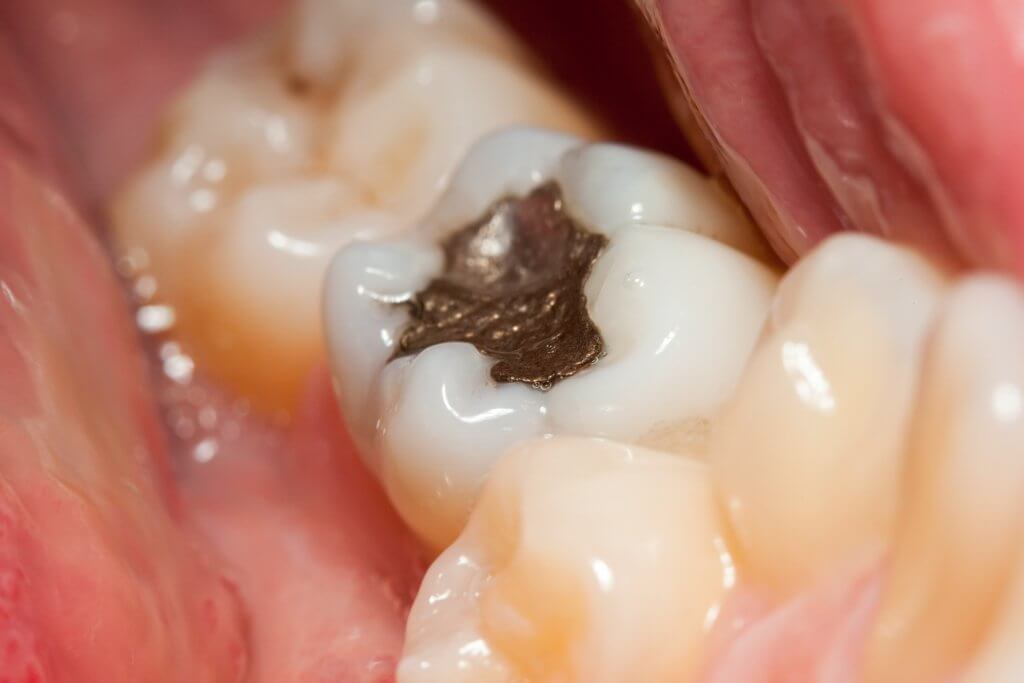Do you have teeth that are decayed or damaged, or simply didn’t develop correctly? If so, you might be a candidate for restorative dentistry. Restoration of teeth has to do with the diagnosis, treatment and prevention of oral disease and other problems.
Whether you need a dental implant, dentures, bridge, dental crowns or even veneers, you might be a candidate for restorative dentistry. In this article we’ll cover the following aspects of restorative care:
- Missing teeth replacement
- Dental implant surgery
- Restorative dentistry’s role in general dentistry
- The difference between restorative and cosmetic dentistry
- The best options for your smile
We hope this helps you understand more about your tooth restoration options so you can maintain great oral health.
What is restorative dentistry?
According to the British Society of Restorative Dentistry (BSRD):
“Restorative dentistry is the study, examination and treatment of diseases of the oral cavity, the teeth and their supporting structures.”
To put it in plainer English, restorative dentistry is any dental work carried out to treat problems affecting the teeth and gums and to restore their function and aesthetics. This includes:
- Tooth fillings
- Treating gum disease (periodontology)
- Root canal treatment (endodontics)
- Replacing and restoring teeth using dental implants, bridges, crowns, and veneers (prosthodontics)
General dentists in the UK can carry out most of this work, but they may also undergo specialist education to become a periodontologist, endodontist or prosthodontist. Diplomas in Restorative Dentistry are available at some universities in the UK.
You can watch the video below for a quick overview of the main kinds of restorative dentistry, but then continue reading for a more detailed explanation.
Types of tooth restoration
Now that you know what restorative dentistry is, let’s have a look at some of the most common types of dental restorations in the UK:
Dental implants
Dental implants are used to replace missing teeth. They are a natural-looking solution and the closest you’ll get to a real tooth. However, because of the materials and expertise involved with placing implants, they are one of the most expensive types of restorative dentistry.
Implants can be used to support a single crown, a tooth bridge, or a full arch of dentures.
All-on-4 implants are a more affordable way to replace an entire arch or a full mouth of teeth instead of getting separate implants for each tooth. This type of implants consists of 4 or 6 implants placed in an arch to secure a full arch of false teeth.
You might also consider mini dental implants, which are smaller in size and cheaper than traditional implants, but aren’t generally as strong or long-lasting.
If you’re thinking of replacing a tooth with an implant but are worried about the cost, you’ll be glad to know there are routes to affordable dental implants. You might even be able to get dental implants on the NHS, or, if you’re fortunate, find a way to get free dental implants via another route.
You can find out more in our guide to the pros and cons of dental implants and the comparison between dental bridges and implants.
Sinus lift and bone graft
Sometimes, a patient may not have sufficient bone in their upper jaw to support a dental implant. In this case, the dentist will recommend a sinus lift. A sinus lift is a surgical procedure that grafts bone to the upper jaw. The maxillary sinus membrane is lifted upwards, making space for the additional bone. If you want more information about this procedure you can read our sinus lift article.
Dental bone grafts can be performed on any part of the jaw if there is insufficient bone to support an implant. This may be because of tooth loss, periodontal disease or trauma.
Dental crowns and caps

A dental crown is a tooth-shaped cover that either fits over a damaged tooth or attaches to the abutment of an implant. Dental glue or cement is usually used to affix the restoration. Crowns can be used for the following reasons:
- Restore a broken or damaged tooth
- Strengthen a weakened tooth
- When a filling isn’t an option
- Approve esthetics
- Reinforce tooth seal after a root canal
Crowns can be made from a variety of materials including porcelain, gold, and ceramic such as Emax crowns. Temporary tooth caps are made from plastic or metal and permanent crowns are generally made from higher quality materials like porcelain. The cost of your crown will depend on the material used.
To find out more about tooth restoration with dental crowns, read our guide with plenty of dental crown information.
Dental bridges
Are you missing one or more teeth? If so, your dentist may recommend that you get a dental bridge. A dental bridge is a dental prosthesis that ‘bridges’ the gap between two teeth.
There are different types of dental bridges. The most common type is a fixed bridge, which consists of a crown on either side of one or two pontics (artificial teeth). The crowns fit over the neighbouring teeth, thus securing the bridge in place. One downside of this sort of bridge is that adjacent teeth must be filed down for the crowns to fit.
A bridge can also be attached to dental implants to replace three or four missing teeth in a row, as pictured.
Our dental bridge information page has more details about the different types and costs involved.
Dentures
Dentures are also known as false teeth and are a type of dental prosthesis for people that are missing any or all of their teeth. Dentures can help patients with no teeth regain their ability to eat and speak naturally. They also help to protect the remaining teeth (saving them from overuse or too much pressure while chewing) and they can stop the face from sagging inwards.
There are various denture types including:
- Full and partial
- Temporary and permanent
- Fixed or removable
- Implant-supported
- Acrylic, metal and flexible dentures
While dentures aren’t as good a replacement for missing teeth as dental implants are, they can still help increase the quality of life for many patients missing one or more teeth. They can become loose and uncomfortable as your mouth changes shape over time, but a professional denture reline and good denture adhesive can help with these problems.
Knowing how to clean dentures properly will help reduce changes over time and maintain durability to ensure your dentures have a long lifespan.
We have a separate page about dentures and false teeth to help you understand if this is a good tooth replacement option for you.
Dental fillings

A dental filling is another type of dental restoration that is used to repair damage caused by tooth decay, in order to prolong the life of your damaged tooth. Over 70% of the UK population have at least one filling, so perhaps you’re already familiar with this procedure. If you’d like to know more about dental fillings, you can read our full dental filling article.
There are two main types of fillings: amalgam (silver) and composite (tooth-coloured). Amalgam fillings are very common in the UK, partly because they’re the cheaper option usually offered on the NHS. However, they are also quite controversial because they contain mercury. Most experts agree that they are completely safe and a very effective way to repair teeth, but you may still prefer to pay the extra for white fillings. You can read more about amalgam fillings vs. composite here.
Wondering if you can do your own fillings at home? You can buy dental repair kits which are helpful for short-term repair of fillings, damaged teeth, and loose crowns. However, these are only designed to work temporarily while you arrange the dental care you need.
Root canal
A root canal is perhaps one of the most dreaded dental restoration treatments. It involves drilling inside the tooth in order to remove any decay that resides inside the roots. This treatment is used to save a tooth when a cavity has developed too far for a simple filling.
It’s important to keep your natural teeth if possible. Dental implants are a good replacement, but nothing is as good as your natural teeth. And you don’t actually need to dread root canal work, thanks to the anaesthetic technology available today. In fact, it shouldn’t feel any different than getting a regular filling, although it may take a little longer. Find out more about this tooth-saving measure in our full root canal guide.
Associated treatments
Dental sedation
Dental sedation is an important part of not just restorative dentistry, but also tooth extractions and sometimes emergency dentistry. There are various types of sedation, ranging from inhalation sedation which just relaxes you, to IV sedation which has a much stronger effect and stops you from remembering the procedure.
Dental sedation has minimal risks and is especially helpful in patients who experience dental anxiety. If you want to read more about the types of sedation and how they work, you can read our full guide to sedation dentistry.
Panoramic x-ray

A panoramic x-ray is what dentists use to see your teeth, jawbones and general facial structures, all captured in a single image. These x-rays are used to diagnose oral health problems and plan some types of dental restorations, like implants.
Some people worry about the safety of x-rays, but in reality, they are extremely safe when performed using the correct safety precautions.
The problems with missing teeth
Missing teeth aren’t just aesthetically problematic, they can also have serious consequences to your oral health and overall health in general. Missing teeth can make it harder to eat and speak, and they can also cause the muscles in your face to weaken and sag inwards. What’s more, missing teeth can lead to the deterioration of your jawbone.
If you have missing teeth, it’s important that you speak with your dentist about options for replacement. In the meantime, if you want to know more about the adverse effects of missing teeth and the options available to you to replace them, this article will help explain everything.
Given our hectic schedules, it’s easy to take healthy teeth and gums for granted, despite the fact that we need them just to function normally every day. That’s why it’s so devastating for most of us when something goes wrong–we can’t eat or drink right, which can’t help but affect our health and daily routine. When dental disease or damage is left untreated, the negative health consequences can go beyond painful teeth and gums. Without timely restorative treatment, you increase your risk of:
- Further damage to your surrounding teeth
- Infection spreading to surrounding teeth and gums
- Tooth loss
- Sepsis (blood infection)
- Ludwig’s Angina (face and jaw infection)
- Bacterial infection to the heart and/or brain
Dr. Shane Porter
Restorative dentistry costs
So how much do all of these dental restoration procedures cost anyway? Have a look at the table below for some average private dental care prices.
Treatment | Approximate cost |
Dental implants | Around £2,000 per tooth, or £25,000+ for a full mouth |
All-on-4 implants | From £7,000 per arch |
Dental bridges | £250 - £800 (traditional fixed), £2,900+ (implant-supported) |
Dental crowns | £250 - £600 (metal), £350 - £950 (ceramic) |
Dentures | £200 - £2,500 (traditional), £4,000 - £14,000 (implant-supported) |
Sinus lift surgery | £200 - £2,000 |
Dental filling | £30 - £160 (amalgam), £40 - £250 (composite) |
Root canal | £100 - £700 |
Panoramic x-ray | £20 - £75 |
Can I get restorative dentistry on the NHS?
Most of the restorative procedures mentioned above are available on the NHS, although with certain limitations. For example, cosmetic white fillings may only be offered on front teeth, where they are clearly visible. If you want a white filling on one of your back teeth, rather than a silver amalgam one, you will need to pay for private dental care.
The NHS also doesn’t provide treatments that are considered cosmetic, for example, veneers and dental implants. Dentures and bridges are the standard NHS options for missing teeth. Read our article about NHS dental charges in the UK for more information.
Conclusion

Thanks to restorative dentistry, many people who have damaged teeth, whether due to developmental problems, trauma or decay, can regain proper function again in their mouths. Restorative dental treatment isn’t just important for your oral health, but for your overall health as well. If you think you might need a tooth restoration, your dentist will help you understand suitable options.
FAQs
What is the difference between restorative vs cosmetic dentistry?
With restorative dentistry, the primary concern is keeping your mouth healthy and functioning, while the focus of cosmetic dentistry is improving the look of your smile. That said, restorative dentistry and cosmetic dentistry often overlap.
What is major restorative dentistry?
Major restorative dentistry includes significant treatment such as crowns, bridges, dentures and implants. This is opposed to basic teeth restoration such as fillings.
Are veneers considered restorative?
Dental veneers are considered to be both cosmetic and restorative dentistry. That’s because not only do they improve the appearance of teeth, but they also help to reduce tooth sensitivity, help maintain gum health, and can protect your existing tooth from damage.
British Dental Health Foundation: Is your smile at risk? Consulted 19th February 2024.
Sunstar: 2021 Oral health Awareness Study. Consulted 4th January 2024.




